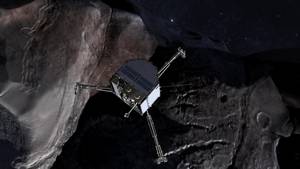Rosetta space probe reaches comet
Interview with
This week the European Rosetta probe has caught up with the comet it's been chasing for more than ten years. Rosetta can now finally begin to deepen our understanding of these mystical entities. To find out more, Graihagh Jackson spoke to one of the people who designed the Rosetta probe: Emanuele Cupido from Imperial College London.
chasing for more than ten years. Rosetta can now finally begin to deepen our understanding of these mystical entities. To find out more, Graihagh Jackson spoke to one of the people who designed the Rosetta probe: Emanuele Cupido from Imperial College London.
Emmanuel - This week, Rosetta began its real mission. After 10 years in space, Rosetta has now reached the comet and will start orbiting around it. So, the real data will start coming down to Earth from the next week onwards.
Graihagh - And this is the first time it's ever been done, isn't it?
Emmanuel - That is correct. There have been other missions which flew past comets whereas Rosetta will be with the comet for a year and a half. So, this is why Rosetta is very ambitious. One other aspect is, there's a bunch of people in Germany at the European Space Operation Centre who are in charge of driving the spacecraft while the spacecraft is 400 million kilometres away from Earth while being hit by gas and dust. In theory, there could be chunks of rock coming off the comet and heating the spacecraft. So, there are all sorts of challenges with this mission.
Graihagh - You sort of touched a bit on why Rosetta really is so ambitious, but why is it so important to find out about comets?
Emmanuel - Comets are perhaps the least studied and understood of celestial bodies because they come and go. So, it's very difficult to study them from Earth or from space because they are not there most of the time. you need to go and find them. On the scientific side, comets brought life to earth in the forms of hydrocarbons perhaps which then started to combine and react with the primordial environment. So, one of the aims of Rosetta is to go and detect in situ the chemical and physical properties of the comet and find out what a comet is actually made of, whether there are dusts and water, ice or more interesting chemical compounds.
Graihagh - So, by looking at something like a comet, you can actually tell a bit about the origins of Earth.
Emmanuel - Well, that will be the ultimate goal. If indeed, the scientists manage to make a link between what's on the comet and the theories of the origin of life on Earth, that will certainly be probably one of the discoveries of the century.
- Previous School of hard hacks
- Next Video games: good or bad?









Comments
Add a comment